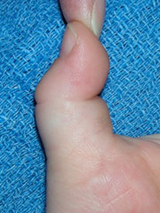What are trigger finger and trigger thumb?
A trigger finger or trigger thumb occurs when the tendons that flex the finger enlarge and aren’t able to slide smoothly within the tunnel the tendons pass through. This causes your child’s finger or thumb to pop or click when she tries to straighten it.

The condition is often painless, but your child may also experience pain when straightening her digits and her finger may get stuck in a crooked or bent position.
In children, the most common digit involved is the thumb. Trigger thumb occurs in approximately three out of 1,000 children at 1 year of age.
When severe, a child’s finger or thumb can’t be straightened on its own and needs to be corrected with surgery.
Causes
In children, trigger finger and thumb are not caused by an injury or other medical issues. The condition occurs when the tendons that move the finger and thumb enlarge and don’t slide smoothly through the tendon sheath (or tunnel) when the finger is moved.
Although it’s rarely noticed at birth, trigger finger and thumb can be present in infancy. The condition is also often found in older children between the ages of 1 and 4.
Signs and symptoms
Some common signs of trigger finger and thumb include:
- Stiffness in the affected finger or thumb
- A painful popping or clicking when the finger or thumb is bent and straightened
- A finger or thumb that gets stuck in either a bent or straight position
- Symptoms that are worse in the morning
In some cases, these symptoms may be associated with an inflammatory condition such as juvenile idiopathic arthritis.
Testing and diagnosis
In order to determine the best course of treatment for your child, doctors at Children’s Hospital of Philadelphia (CHOP) will conduct a thorough physical exam. Imaging tests, such as X-rays, are rarely necessary.
Treatment
In very young children, trigger thumb or finger will resolve on its own for up to 30 percent of children before they reach their first birthday. After that age, it’s unlikely this condition will go away without treatment.
Surgery to correct trigger thumb is usually performed when a child is between 1 and 3 years of age. In this procedure, your child’s surgeon will release the tendon from the tendon sheath where it is catching, allowing the tendon to glide more smoothly.
Treatment of trigger fingers other than the thumb will include evaluation for any underlying inflammatory condition. Treatment may include surgical removal of a part of the tendon or decompressing the tendon sheath to allow the tendon to glide more smoothly.
Your child will be able to go home the same day as her trigger finger or trigger thumb release surgery. She will need to leave a soft dressing over the incision for five days after surgery. Use of the affected hand will be restricted during this time.
Once the dressing is removed, your child will be able to use her hand normally and without restriction. The absorbable sutures used during surgery will fall out on their own within two weeks of surgery.
Follow-up care
Your child will need to be examined by the hand surgeon two weeks after surgery. Many children do not require any other follow-up visits.
Resources to help
Trigger Finger and Trigger Thumb Resources
Hand and Arm Disorders Program Resources
We have compiled resources to help you find answers to your questions and feel confident with the care you are providing your child.
